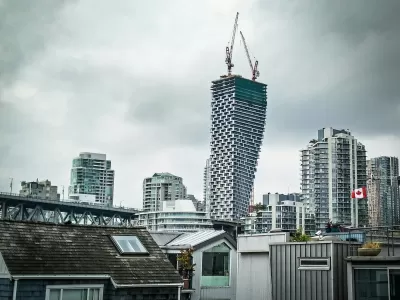To meet zoning constraints, the twisting skyscraper uses an innovative design that optimizes its small footprint.

A helix-shaped high-rise designed by Bjarke Ingels Group in downtown Vancouver, British Columbia used its innovative design to skirt zoning regulations and fit the 500-unit building into a small footprint. “The high-rise couldn’t be too close to the street, it had to be at least 30 meters (nearly 100 feet) away from the Granville Bridge and it couldn’t cast shadows on a nearby park,” explains Amelia Pollard in Bloomberg CityLab.
Because the 30 meter bridge setback only applies to parts of the building below 30 meters in height, BIG created a design that widens as it rises and ensures that the building doesn’t block sunlight from the adjacent park. “Because of its twisting design, structural engineering played a large role in the construction. BIG consulted with engineering firms Glotman Simpson and Buro Happold to ensure the tower — which steps out around 80 feet — was stable enough to meet stringent building codes in this seismically active city.” The 80-foot tower features a stainless steel facade that reflects light.
According to Pollard, “The property also includes two adjacent, triangular lots that are sandwiched by the bridge and its off-ramps. The two buildings house a portion of University Canada West and ground-level retail,” utilizing the underdeveloped space around the bridge.
FULL STORY: Vancouver Skyscraper Twists Around Zoning Restrictions

Planetizen Federal Action Tracker
A weekly monitor of how Trump’s orders and actions are impacting planners and planning in America.

Restaurant Patios Were a Pandemic Win — Why Were They so Hard to Keep?
Social distancing requirements and changes in travel patterns prompted cities to pilot new uses for street and sidewalk space. Then it got complicated.

Map: Where Senate Republicans Want to Sell Your Public Lands
For public land advocates, the Senate Republicans’ proposal to sell millions of acres of public land in the West is “the biggest fight of their careers.”

Maui's Vacation Rental Debate Turns Ugly
Verbal attacks, misinformation campaigns and fistfights plague a high-stakes debate to convert thousands of vacation rentals into long-term housing.

San Francisco Suspends Traffic Calming Amidst Record Deaths
Citing “a challenging fiscal landscape,” the city will cease the program on the heels of 42 traffic deaths, including 24 pedestrians.

California Homeless Arrests, Citations Spike After Ruling
An investigation reveals that anti-homeless actions increased up to 500% after Grants Pass v. Johnson — even in cities claiming no policy change.
Urban Design for Planners 1: Software Tools
This six-course series explores essential urban design concepts using open source software and equips planners with the tools they need to participate fully in the urban design process.
Planning for Universal Design
Learn the tools for implementing Universal Design in planning regulations.
Heyer Gruel & Associates PA
JM Goldson LLC
Custer County Colorado
City of Camden Redevelopment Agency
City of Astoria
Transportation Research & Education Center (TREC) at Portland State University
Camden Redevelopment Agency
City of Claremont
Municipality of Princeton (NJ)





























